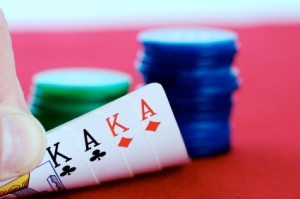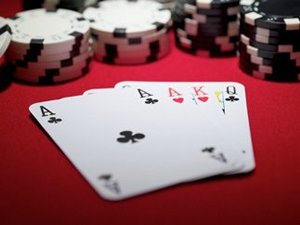Pot-Limit Omaha Games Seven general guidelines
Editor’s note: This column is an edited excerpt from Jeff Hwang’s book, Advanced Pot-Limit Omaha: Small Ball and Short-Handed Play.
So, you are looking to start a regular small-stakes pot-limit Omaha (PLO) game in your local cardroom, and you want it to run more than a few times without everybody else going broke and ending the game. The question is this: How do you structure a sustainable small-stakes PLO game?
Before we answer the question, let’s first establish what the issues are in doing so, and then we can generate some general guidelines:
1. PLO games scale rapidly; with the help of the straddle, an uncapped $2-$5 game with $2,000 or $3,000 stacks may play several times bigger than a $2-$5 game with $500 to $1,000 stacks.
2. A $2-$5 PLO game tends to play bigger than $5-$10 no-limit hold’em, and sometimes significantly so when the game is played without a maximum buy-in.
3. PLO should be a red-chip game after the flop (explained further below).
4. It is simply not feasible to play straight $1-$2 PLO in a live cardroom — unless you like raising to $7 or $8 and tracking $1 chips for betting purposes after the flop, or otherwise betting $15 after the flop in red-chip games regardless of whether six or seven people saw the flop, and so on. Playing with $1-$2 blinds generally requires an additional mechanism, such as a third blind/straddle or the use of a separate bring-in amount.
5. PLO is meant to be played after the flop, and as such is meant to be played with relatively deep stacks.
6. Short-stackers are bad for the game.
The fact that PLO games scale so rapidly is a major problem in structuring sustainable games, because if you are playing in an uncapped game, bigger players can sit down with whatever amount they want and effectively — and dramatically — change the size of the game by straddling, turning a $2-$5 game into a $2-$5-$10 game without making the game a short-stack affair. In doing so, the bigger players can effectively price out the smaller players who were looking to play a smaller game.
This means that if you are going to structure a sustainable small-stakes game, you need to have a maximum buy-in in order to control its size. In addition, it may be beneficial for the longevity of the game not to allow the straddle option, as the straddle is the mechanism used to change the size of the game.
On the second point, because $2-$5 PLO tends to play bigger than $5-$10 no-limit hold’em, a $500 buy-in game that’s aimed at $2-$5 no-limit hold’em players should have blinds smaller than $2-$5.
That said, PLO should be played as a red-chip game after the flop; in other words, the betting after the flop should be done in $5 increments. The alternative is forcing players and dealers to track betting amounts in single-dollar units, which is impractical.
There are two things that we can gather from the fourth point. One is that there is no reasonable way to structure a PLO game in a live cardroom in such a way as to cater to $1-$2 no-limit hold’em players, who are accustomed to games with $200 and $300 maximum buy-ins. As a result, our focus is primarily on the $500 max buy-in $2-$5 no-limit hold’em players on one level, and the $5-$10 no-limit hold’em players on the next. The other is that games played with $1-$2 blinds should be played with either a mandatory third blind/straddle or a separate bring-in amount, which typically would be $5.
The fifth and sixth points relate to the size of the maximum and minimum buy-in in relation to the size of the blinds. The max buy-in should be high enough to allow room for deep-stack play — probably in the range of 150-200 big blinds — but low enough to keep the game from getting out of control. Meanwhile, the minimum buy-in should be high enough to prevent short-stacking.
Now, some might argue that short-stackers are a part of the game, but in my opinion, there is no inherent reason why they should be in the game to begin with. In fact, the only real reason that they even exist in certain games is because of a flaw in the way those games are structured; namely, because the minimum buy-in is set too low and/or because of the straddle option. For example, if you have a $200 minimum buy-in in a $2-$5 PLO game, players can buy in with a stack of 40 big blinds; but if you allow the straddle and everybody is doing it, players can now buy in with a stack of effectively 20 big blinds in what is now effectively a $2-$5-$10 game.
That said, this problem needs to be accounted for when setting the minimum buy-in amount.
This brings us to seven general guidelines for structuring sustainable small-stakes PLO games, from which we can derive viable game structures.
General Guidelines for Structuring Sustainable Small-Stakes PLO Games
1. Games should have a maximum buy-in.
2. Games should not allow a straddle.
3. Games aimed at $2-$5 no-limit hold’em players or $500-max buy-in players should have blinds smaller than $2-$5.
4. Regardless of the size of the blinds, small-stakes PLO games should be red-chip games after the flop.
5. Games using $1-$2 blinds should have a third blind/straddle or separate bring-in amount.
6. The maximum buy-in should be large enough to allow for deep-stack play, but low enough to keep the game from getting out of control.
7. The minimum buy-in should be high enough to prevent
short-stacking.
For small-stakes games that are aimed at $2-$5 no-limit hold’em players, you should generally have a $200 minimum buy-in and a $500 maximum buy-in, and the blinds should be smaller than $2-$5. In addition, the games should be red-chip games after the flop, wherein the betting is done in $5 increments. That said, there are two basic structures that I’ve played that work exceptionally well: The first is $1-$2 or $2-$3 blinds and a $5 bring-in, and the second is simply $1-$3 or $2-$3 blinds.
If I had to start a new game aimed at $2-$5 no-limit players from scratch, my choice would be to play with $2-$3 blinds and a $5 bring-in, a $200 minimum/$500 maximum buy-in, and no straddle.
This article was originally written by Jeff Hwang. Jeff Hwang is a semiprofessional player and author of Pot-Limit Omaha Poker: The Big Play Strategy. His latest book is Advanced Pot Limit Omaha Vol.1 and will be releasing Vol 2.
Submit your review | |








